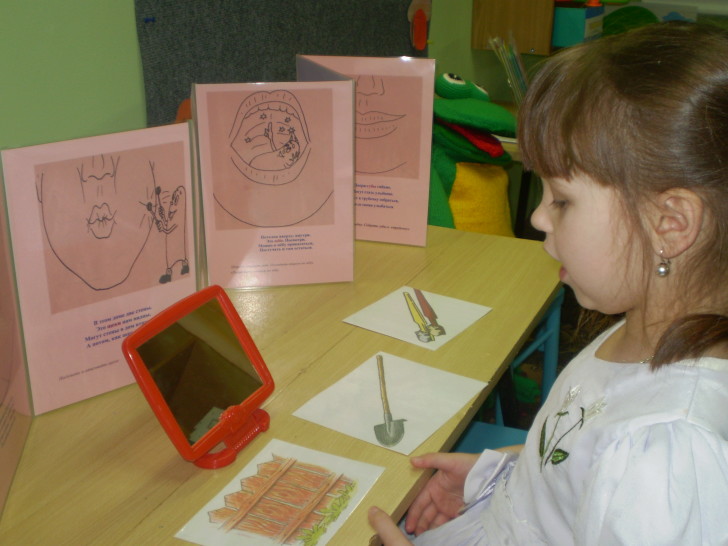How to teach a child to pronounce the letter and sound "L": 9 exercises for training at home

When learning language skills, children often distort words. They experience difficulties in the pronunciation of individual sounds. The notorious “rrrr” is known to many, but what if the child changes the letter “l”? The defect is easy to fix. Parents should show the child to a speech therapist - the specialist will establish the cause of the defect and determine the methodology of classes that will help eliminate it.
If there are speech disorders, it is better to show the child to a specialist if possible: he will determine the degree of deviation and help the family cope with itWhat causes a defect?
Most of the sounds are perfectly mastered by a child by 4-4.5 years. If you notice that your baby is having difficulty pronouncing a few letters or a single “l” sound, look for reasons. One of the factors may be a speech defect in an adult who is constantly in contact with the baby. The child imitates the speech of mom or dad. Problems in pronunciation have also been observed in children growing up in bilingual families. It is difficult for a child to learn two languages at once, he gets confused, replaces the sounds of one language with the sounds of another. Among the physiological reasons, we note the following:
- violations that have arisen during the development of speech hearing (the child hears sounds incorrectly);
- pathology of the auditory apparatus and speech breathing;
- changes in the structure of the articular apparatus (in the case of the sound “l”, this may be a shortened frenulum).
All anatomical changes are determined by a specialist. Self-diagnosis often leads to incorrect treatment and aggravation of the defect.
If a child has a shortened frenulum, do not worry. For a long time, the defect was corrected with an incision, and today a new technique has been developed in which the frenulum is stretched to the required size with the help of special exercises.
Variants of pronunciation of the distorted sound "l"

This article talks about typical ways to solve your questions, but each case is unique! If you want to know from me how to solve exactly your problem - ask your question. It's fast and free!
Trying to pronounce "l", the child can replace it with other sounds. There is no definite dependence on the cause that caused the defect - the baby speaks in a way that is easier for him. The sound might be:
- the child skips the letter "l" (shovel - opata);
- replaces "l" with "y" (horse - walk);
- pronounces the sound “y” instead of the sound “l” (milk - moyoko, spoon - yoshka);
- speaks a hard "l" well and replaces a soft letter with another.
Correct articulation
To fix something, you need to know how it looks right. It's the same with the sounds we make. It is unlikely that you will be able to pronounce the letter "p" without connecting your lips. In order to get the sound "l", you need:
- rest the tip of the tongue against the base of the upper teeth or into the gap formed between the upper and lower teeth;
- pronouncing the letter, strongly release the air along the sides of the tongue;
- the edges of the tongue should not touch the upper and lower teeth located on the sides of the jaw.
If the speech therapist did not find serious problems with the articulatory apparatus in your baby, the correct pronunciation of “l” can be easily put at home. A few lessons with the baby are enough to teach him how to reproduce sound well. A few special exercises will make your task easier and give pleasure to the child. They will improve the mobility of the muscles of the larynx, tongue and lips.
 In order for the child to understand where he makes a mistake, it is necessary to put him in front of a mirror and work out the correct setting of the tongue and lips.
In order for the child to understand where he makes a mistake, it is necessary to put him in front of a mirror and work out the correct setting of the tongue and lips. Learning to pronounce the sound "l"
Classes at home are comfortable for both the child and the parents. Specialists have developed various exercises that you can do with your baby, turning them into a fun game. Children love to make faces, but our exercises are also beneficial. Through a fun and exciting action, we teach the baby, we give the opportunity to train his tongue for the correct pronunciation of "l". List of exercises:
- Smile . Ask the baby to smile widely without parting his lips. Let him hold a smile for 8-10 seconds. Repeat the exercise 7-8 times a day.
- Breeze. Open your mouth a little, stick the tip of your tongue between your lips, and “bite” it slightly, squeezing your lips. Leaving the tongue in this position, it is necessary to blow strongly for three minutes.
- clatter. The kid should click like a horse, changing the intensity of the sound. Ask the child not to move the lower jaw, only the tongue and upper jaw click. The first part of the exercise is done with acceleration, in the second part the clatter should be quiet, as if the horse is sneaking.
- Delicious jam. Invite the child to lick his lips with his tongue as if he had eaten something very tasty. Movements should be wide, circular.
- Long tongue . Favorite exercise for kids. Children stick out their tongue to its full length and try to get it to the nose or chin.
- tubule. Ask your child to roll their tongue several times a day.
- Long "s". The tip of the tongue is retracted deep into the mouth, the back of the tongue rises to the sky, the child pulls the sound “y”. The exercise is difficult, but it improves the flexibility of the tongue.
- Breath. Accompany the lessons with the improvement of breathing skills. Let the baby blow bubbles more often, encourage his desire to sing. In summer, the baby can blow off ripe dandelions.
- Fine motor skills. Fine motor skills exercises stimulate the nerve endings. Sculpting, drawing, cutting and gluing applications have a positive effect on the development of speech skills and enhance the intellectual development of a small person.
It will also be useful to pronounce tongue twisters and combinations of letters in which "l" is adjacent to different vowels.
How to conduct classes correctly?
When starting classes, remember that you have a small child in front of you. The best way to teach him something is through play. Speech therapy exercises carried out under pressure quickly bother babies, so you can’t force a child to repeat them for a long time. Start with 1-2 times a day for 3-4 repetitions. Use your own example. Sit with the baby near the mirror so that he can see how he is doing. Children love to imitate the actions of adults, use their interest for educational purposes. Accompany praise for each success of the crumbs, explain to him what you are learning and why.
In what situations do you need the help of a speech therapist?
Despite the ease of adjusting the sound, it may turn out that practicing at home will not lead to success. The reasons may be different:
- Russian is not your native language for your family, and its adult members speak with an accent;
- one of the adults already has speech defects and it is difficult for him to conduct classes;
- long classes could not help the baby learn to pronounce the letter "l".
In such situations, you need to contact a specialist. A speech therapist will help you adjust the exercises, suggest other ways to correct them.
You will need considerable patience and the ability to lure a child. The slightest progress should be noticed and marked with praise. If something doesn’t work out for the baby, do not scold him, so as not to discourage the desire to learn.
Difficulties in pronouncing the letter "r" become a frequent problem (for more details, see the article:). We recommend that you refer to one of our materials that tells how to deal with this problem. The principle is almost the same: it is necessary to stimulate children so that they speak words with this sound more often. Learn the articulation when pronouncing "r", show it to your baby. Use in the classroom pictures of animals with a “r” in their name, learn poetry and tongue twisters with it.
(3 rated for 5,00 from 5 )
- Essay by a speech pathologist
- Defectologist-speech therapist: what kind of specialty, where to study
- Speech therapy massage for children at home
- Creation of a developing environment in a speech therapy room
- The development of fine motor skills of hands in preschool children
- Sound analysis of the word: what is it and how to do it correctly
- Kemerovo Savelyeva Elena Nikolaevna

 Live Journal
Live Journal Facebook
Facebook Twitter
Twitter